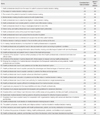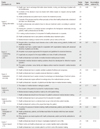Abstract
Purpose
The study was done to develop a shared decision-making scale for end-of-life patients in Korea.
Methods
The process included construction of a conceptual framework, generation of initial items, verification of content validity, selection of secondary items, preliminary study, and extraction of final items. The participants were 388 adults who lived in one of 3 Korean metropolitan cities: Seoul, Daegu, or Busan. Item analysis, factor analysis, criterion related validity, and internal consistency were used to analyze the data. Data collection was done from July to October 2011.
Results
Thirty-four items were selected for the final scale, and categorized into 7 factors explaining 61.9% of the total variance. The factors were labeled as sharing information (9 items), constructing system (7 items), explanation as a duty (5 items), autonomy (4 items), capturing time (3 items), participation of family (3 items), and human respect (3 items). The scores for the scale were significantly correlated among shared decision-making scale, terminating life support scale, and dignified dying scale. Cronbach's alpha coefficient for the 34 items was .94.
References
1. Briggs L, Colvin E. The nurse's role in end-of-life decision-making for patients and families. Geriatric Nursing. 2002. 23:302–310. http://dx.doi.org/10.1067/mgn.2002.130271.
2. Byun EK, Choi HR, Choi AL, Kim NM, Hong KH, Kim HS. An investigative research on the attitudes of intensive care unit nurses and families on terminating life support. Clinical Nursing Research. 2003. 9(1):112–124.
3. Costello J. Nursing older dying patients: Findings from an ethnographic study of death and dying in elderly care wards. Journal of Advanced Nursing. 2001. 35:59–68. http://dx.doi.org/10.1046/j.1365-2648.2001.01822.x.
4. Elwyn G, Hutchings H, Edwards A, Rapport F, Wensing M, Cheung W, et al. The OPTION scale: Measuring the extent that clinicians involve patients in decision-making tasks. Health Expectations. 2005. 8:34–42. http://dx.doi.org/10.1111/j.1369-7625.2004.00311.x.
5. Frank RK. Shared decision making and its role in end of life care. British Journal of Nursing. 2009. 18:612–618.
6. Hilden H, Honkasalo M. Finnish nurses' interpretations of patient autonomy in the context of end-of-life decision making. Nursing Ethics. 2006. 13:41–51. http://dx.doi.org/10.1191/0969733006ne856oa.
7. Hilden H, Louhiala P, Honkasalo M, Palo J. Finnish nurses' views on end-of-life discussions and a comparison with physicians' views. Nursing Ethics. 2004. 11:165–178. http://dx.doi.org/10.1191/0969733004ne681oa.
8. Holcomb LE, Neimeyer RA, Moore MK. Personal meanings of death: A content analysis of free-response narratives. Death Studies. 1993. 17:299–318. http://dx.doi.org/10.1080/07481189308252627.
9. Jo KH. Nurse's conflict experience toward end-of-life medical decision-making. Journal of Korean Academy of Adult Nursing. 2010. 22:488–498.
10. Jo KH. Development and evaluation of a dignified dying scale for Korean adults. Journal of Korean Academy of Nursing. 2011. 41:313–324. http://dx.doi.org/10.4040/jkan.2011.41.3.313.
11. Jo KH, An GJ, Kim GM. Future changes and directions for the construction of Medical Decision-Making System in Korea: Focused on delphi surveys. Korean Journal of Medical Ethics. 2011. 14:44–54.
12. Johnston B, Smith LN. Nurses' and patients' perceptions of expert palliative nursing care. Journal of Advanced Nursing. 2006. 54:700–709. http://dx.doi.org/10.1111/j.1365-2648.2006.03857.x.
13. Kriston L, Scholl I, Holzel L, Simon D, Loh A, Harter M. The 9-item shared decision making questionnaire (SDM-Q-9). Development and psychometric properties in a primary care sample. Patient Education and Counseling. 2010. 80:94–99. http://dx.doi.org/10.1016/j.pec.2009.09.034.
14. Lee SM, Kim SY, Lee HS. The process of medical decision-making for cancer patients. Korean Journal of Medical Ethics. 2009. 12:1–14.
15. Lynn MR. Determination and quantification of content validity. Nursing Research. 1986. 35:382–385.
16. Meraviglia MG, McGuire C, Chesley DA. Nurses' needs for education on cancer and end-of-life care. Journal of Continuing Education in Nursing. 2003. 34:122–127.
17. Nordgren L, Olsson H. Palliative care in a coronary care unit: A qualitative study of physicians' and nurses' perceptions. Journal of Clinical Nursing. 2004. 13:185–193. http://dx.doi.org/10.1111/j.1365-2702.2004.00816.x.
18. Norton SA, Talerico KA. Facilitating end of life decision making strategies for communicating and assessing. Journal of Gerontological Nursing. 2000. 26:6–13.
19. Ryu CS. SPSS 14.0 for windows. 2006. 5th ed. Seoul: Elite.
20. Scherer Y, Jezewski MA, Graves B, Wu YB, Bu X. Advanced directives and end-of-life decision making: Survey of critical care nurses' knowledge, attitudes and experience. Critical Care Nurse. 2006. 26(4):30–40.
21. Simon D, Schorr G, Wirtz M, Vodermaier A, Caspari C, Neuner B, et al. Development and first validation of the shared decision-making questionnaire (SDM-Q). Patient Education and Counseling. 2006. 63:319–327. http://dx.doi.org/10.1016/j.pec.2006.04.012.
22. Song SJ. Characteristics of Korean family and family therapy. Korean Journal of Family Therapy. 2005. 10:25–44.
23. Stacey D, Legare F, Pouliot S, Kryworuchko J, Dunn S. Shared decision making models to inform an interprofessional perspective on decision making: A theory analysis. Patient Education and Counseling. 2010. 80:164–172. http://dx.doi.org/10.1016/j.pec.2009.10.015.
24. Stacey D, Murray MA, Legare F, Sandy D, Menard P, O'Connor A. Decision coaching to support shared decision making: A framework, evidence, and implications for nursing practice, education, and policy. Worldviews on Evidence-Based Nursing. 2008. 5:25–35. http://dx.doi.org/10.1111/j.1741-6787.2007.00108.x.
25. Suh WS, Lee C. Impact of shared-decision making on patient satisfaction. Journal of Preventive Medicine and Public Health. 2010. 43:26–34. http://dx.doi.org/10.3961/jpmph.2010.43.1.26.
26. Weissman DE. Decision making at a time of crisis near the end of life. Journal of the American Medical Association. 2004. 292:1738–1743. http://dx.doi.org/10.1001/jama.292.14.1738.
27. Willard C, Luker K. Challenges to end of life care in the acute hospital setting. Palliative Medicine. 2006. 20:611–615. http://dx.doi.org/10.1177/0269216306071064.
28. Winter L, Parks SM. Family discord and proxy decision makers' end-of-life treatment decisions. Journal of Palliative Medicine. 2008. 11:1109–1114. http://dx.doi.org/10.1089/jpm.2008.0039.




 PDF
PDF ePub
ePub Citation
Citation Print
Print






 XML Download
XML Download